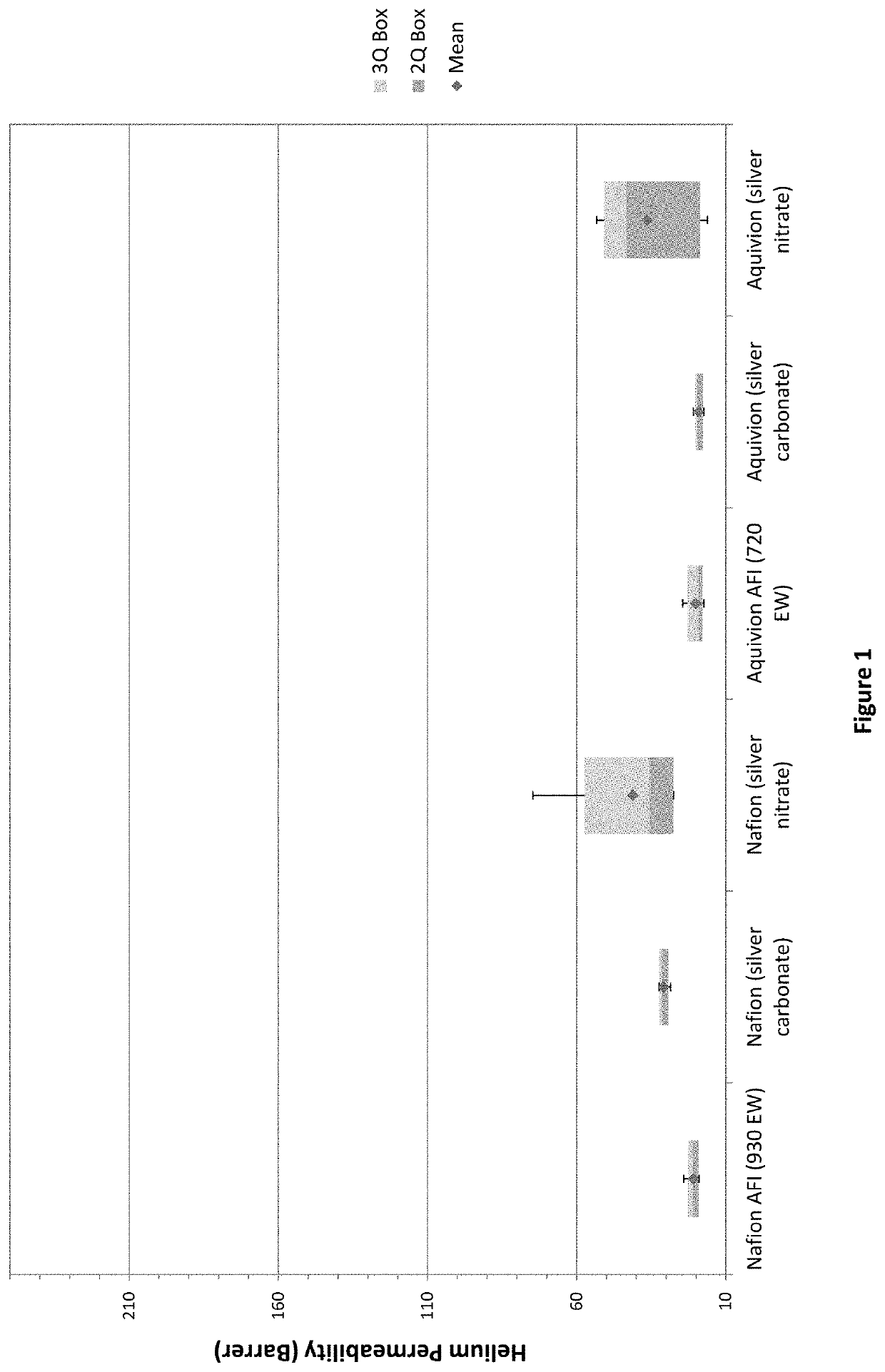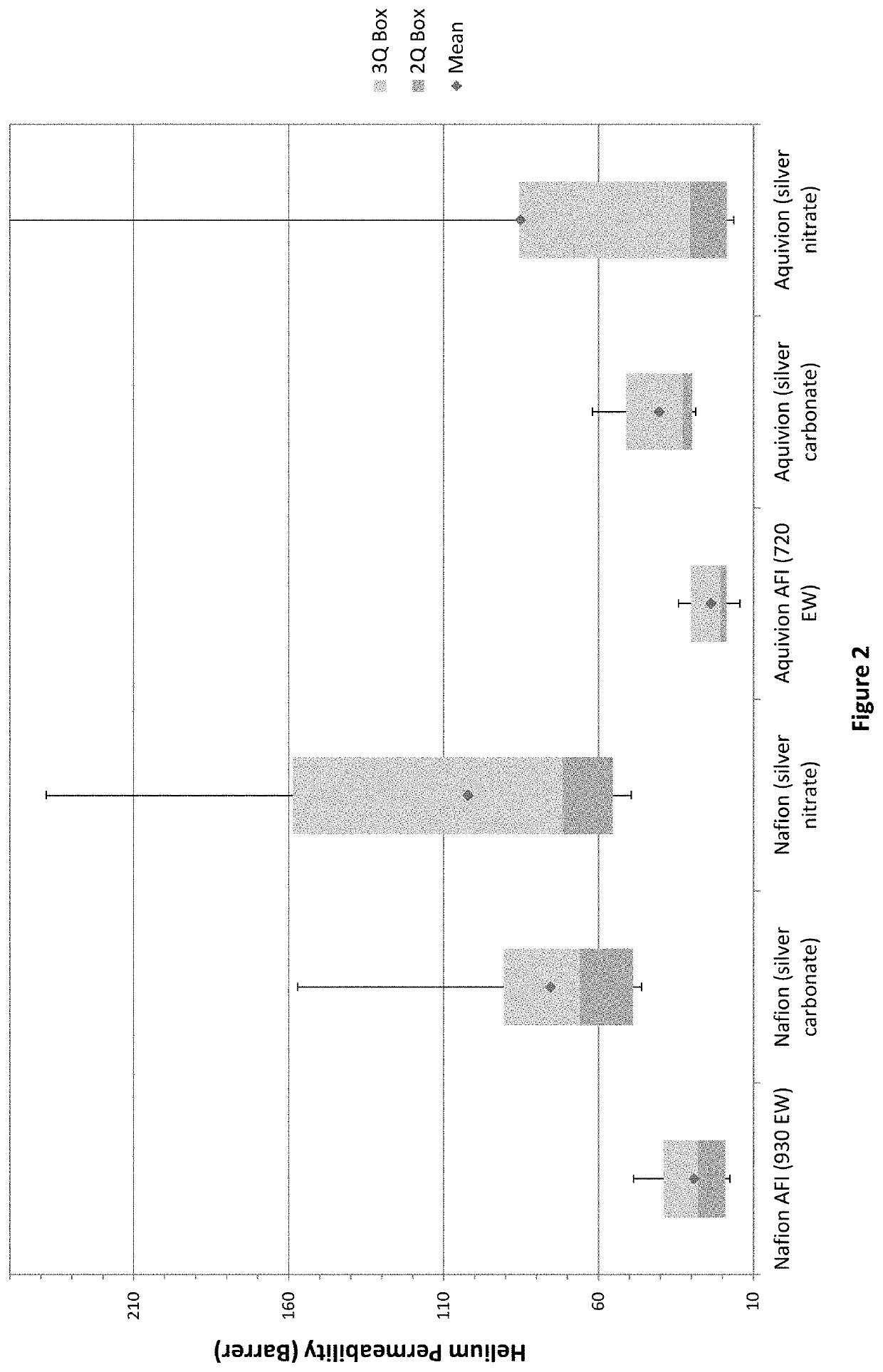Processes for separation of aromatic compounds using a thin film composite membrane
a technology of aromatic compounds and composite membranes, applied in membranes, separation processes, membrane technology, etc., can solve the problems of large-scale capital-intensive facilities and high energy input, difficult industrial separation of alkenes or certain aromatic compounds from alkanes by traditional methods such as distillation, and high cost of fluorinated ionomers, so as to achieve more defect-free effects
- Summary
- Abstract
- Description
- Claims
- Application Information
AI Technical Summary
Benefits of technology
Problems solved by technology
Method used
Image
Examples
example 1
[0034]Nafion® and Aquivion® Solution Preparation:
[0035]2%-w / w solutions were prepared by isopropanol dilution of commercially available Nafion® D2020 acid-form ionomer solutions (Ion Power, New Castle, Del.) and Aquivion® D72-25BS, D79-25BS, and D98-25BS solutions (Sigma-Aldrich, St. Louis, Mo.). The diluted solutions were filtered through a glass microfiber filter, having a porosity of approximately 1-μm, and characterized for concentration by gravimetric drying (5-g samples) to constant weight on a 110° C. hot plate. Nafion® ionomer had an equivalent weight) of approximately 930-g / mole and the Aquivion® ionomers had equivalent weights of 720, 790, and 980-g / mole, respectively.
example 2
[0036]Silver Ionomer Solution Formation:
[0037]Separate quantities of each of the 2% acid-form ionomer solutions prepared in example 1 were converted to the silver-sulfonate ionomer solution by either equilibrium exchange with silver nitrate or by reaction with insoluble silver carbonate. Using silver nitrate, approximately 1 molar equivalent of silver nitrate to sulfonic-acid groups in the ionomer solution was dissolved with magnetic stirring. The solutions were subsequently filtered through 1-μm glass microfiber. Using silver carbonate, acid-form ionomer solutions were magnetically stirred for at least 15 minutes with a 10 to 25% molar excess of silver carbonate to sulfonic-acid groups. The solutions were subsequently filtered through 1-μm glass microfiber to remove excess insoluble salts, resulting in a solution that was substantially free of dissolved ionic species not associated with the silver-sulfonate ionomer. All silver-sulfonate ionomer solutions were stored away from light...
example 3
[0038]Reduced Viscosity of Sulfonic Acid and Silver-Sulfonate Ionomer Solutions:
[0039]Portions of the 2% acid-form ionomer (AFI) and silver-sulfonate ionomer solutions prepared in examples 1 and 2, respectively, were quantitatively diluted to 1% concentrations with isopropanol. Kinematic viscosities were measured using an Ubbelohde capillary viscometer (size 1) in a temperature controlled (25° C.) water bath. Solution densities (g / mL) were measured volumetrically and dynamic viscosities (η) were calculated from the product of density and kinematic viscosity for each solution and the isopropanol solvent (ηsol). The reduced viscosities, which are normalized for ionomer concentration (c) in grams per deciliter (g / dL), were calculated as: ηred=(η / ηsol−1) / c. The reduced viscosities are listed in Table 1 and are known from theory to correlate to the ionomer molecular size in solution. The results showed that the AFI solutions had the highest reduced viscosities and correspondingly largest...
PUM
| Property | Measurement | Unit |
|---|---|---|
| porosity | aaaaa | aaaaa |
| temperatures | aaaaa | aaaaa |
| temperatures | aaaaa | aaaaa |
Abstract
Description
Claims
Application Information
 Login to View More
Login to View More - R&D
- Intellectual Property
- Life Sciences
- Materials
- Tech Scout
- Unparalleled Data Quality
- Higher Quality Content
- 60% Fewer Hallucinations
Browse by: Latest US Patents, China's latest patents, Technical Efficacy Thesaurus, Application Domain, Technology Topic, Popular Technical Reports.
© 2025 PatSnap. All rights reserved.Legal|Privacy policy|Modern Slavery Act Transparency Statement|Sitemap|About US| Contact US: help@patsnap.com


